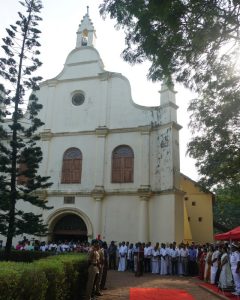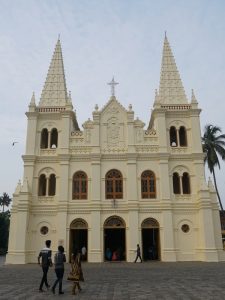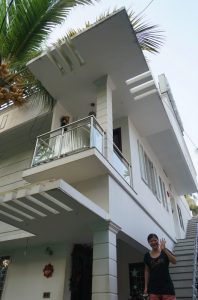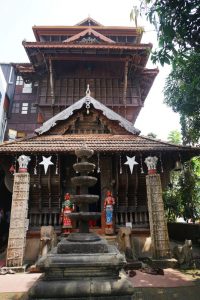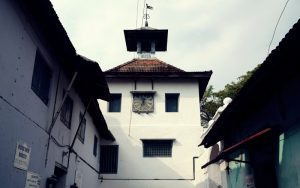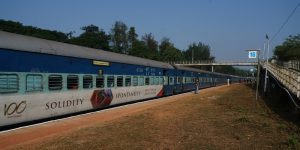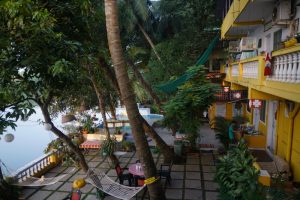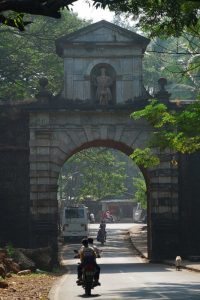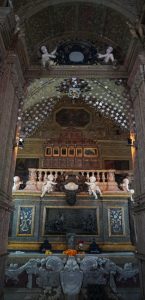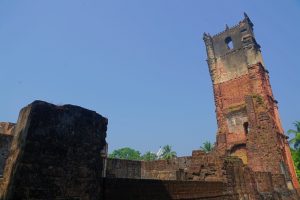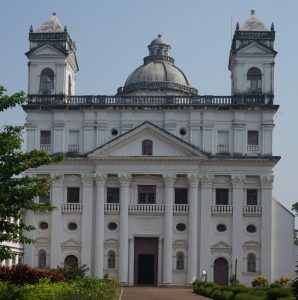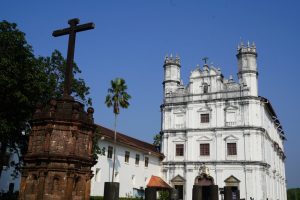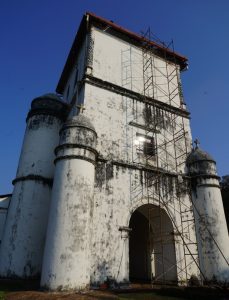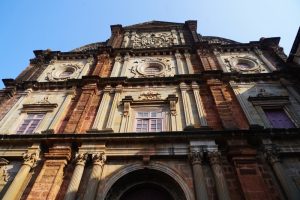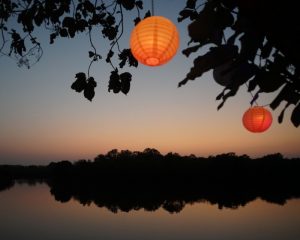December 9 – 13: Kochi & Goa
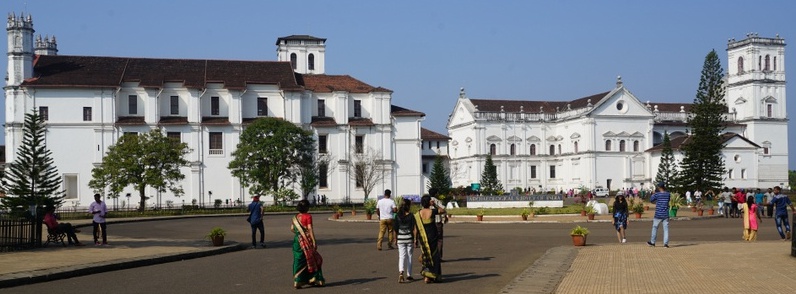
Old Goa, an atmoshperic town with magnificent churches and monasteries built under the Portuguese rule
2 Days in Fort Kochi
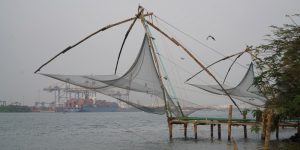 Fort Kochi, also called Old Kochi, is a region in the city of Kochi, a cluster of islandson the Vembanad Lake and one of the finest natural harbour in India. Kochi was a fishing village in the Kingdom of Kochi in the pre-colonial Kerala. The Chinese came to the region during the 14th century and installed Chinese nets. Hence its former name Cochin meaning like China. Mattancherry is the nerve town of old historic Cochin.
Fort Kochi, also called Old Kochi, is a region in the city of Kochi, a cluster of islandson the Vembanad Lake and one of the finest natural harbour in India. Kochi was a fishing village in the Kingdom of Kochi in the pre-colonial Kerala. The Chinese came to the region during the 14th century and installed Chinese nets. Hence its former name Cochin meaning like China. Mattancherry is the nerve town of old historic Cochin.
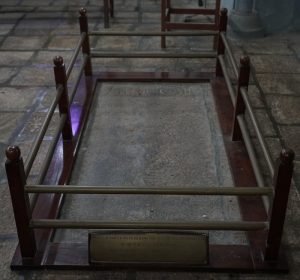 Vasco da Gama (1460s -1524), who landed in Calicut (about 200km north of Kochi) on May 20, 1498, was the first European to reach India by sea in search of spices and treasures. The Rajaj of Kochi granted the territory of today’s Fort Kochi to the Portuguese after Afonso de Albuquerque helped him to fight the forces of the ruler of Kozhikode (also known as Calicut). The Portuguese with the Rajah’s permission built Fort Emmanuel near the waterfront to protect their commercial interests. A permanent Portuguese settlement was set up behind the fort and St Francis Church was built in 1516. Vasco da Gama who died of malaria in Cochin on his third voyage to India was buried at this church. In 1530, his remains were returned to Portugal and his body re-interred in a casket is now placed in a tomb in the Jerónimos Monastery in Belém, Lisbon.
Vasco da Gama (1460s -1524), who landed in Calicut (about 200km north of Kochi) on May 20, 1498, was the first European to reach India by sea in search of spices and treasures. The Rajaj of Kochi granted the territory of today’s Fort Kochi to the Portuguese after Afonso de Albuquerque helped him to fight the forces of the ruler of Kozhikode (also known as Calicut). The Portuguese with the Rajah’s permission built Fort Emmanuel near the waterfront to protect their commercial interests. A permanent Portuguese settlement was set up behind the fort and St Francis Church was built in 1516. Vasco da Gama who died of malaria in Cochin on his third voyage to India was buried at this church. In 1530, his remains were returned to Portugal and his body re-interred in a casket is now placed in a tomb in the Jerónimos Monastery in Belém, Lisbon.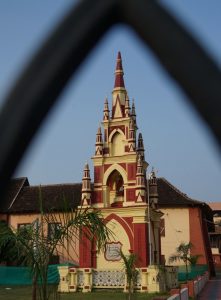
The Dutch captured the territory from the Portuguese in 1683. The British defeated the Dutch in 1795 and controlled Fort Kochi till the Indian independence in 1947.
December 9 Saturday
I like Fort Kochi for its architectures and nostalgic atmosphere. The mix of old houses built by the Portuguese, Dutch and British in the colonial periods and Chinese fishing nets along the river reminds me of its past and rich history.
I had a leisure relaxing day. First, I bought a first class AC on an express night train ‘Madgaon’ on December 10 (USD 59 including fare, tax, agency fee and breakfast). The train would leave at 9:30pm and arrive in Goa at 8:45am on December 11. I would have a lower bed in a four-bedded compartment .
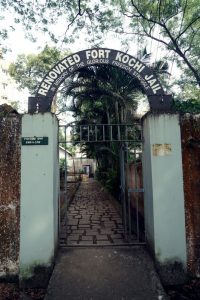 I strolled aimlessly. Though there is little remains of the fort itself, the main streets of Fort Kochi are lined with trees and old houses with flowers on every porch. The gigantic trees were transplanted from Brazil several centuries ago. I am impressed by the number of boutique hotels and hostels located in historical buildings. A Jewish family house is now a hotel with three guest rooms.
I strolled aimlessly. Though there is little remains of the fort itself, the main streets of Fort Kochi are lined with trees and old houses with flowers on every porch. The gigantic trees were transplanted from Brazil several centuries ago. I am impressed by the number of boutique hotels and hostels located in historical buildings. A Jewish family house is now a hotel with three guest rooms.
I watched the Chinese fishing nets and a dozen of men standing in the water fishing with their rods. A warship sailed by. There are many sheds in the main square selling live fish, crabs and shell fish.
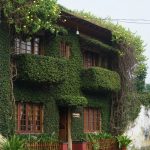 It was getting hot. I stopped at the Indo-Portugese Museum and paid 25 rupees to enter it. Most of the exhibits are religious in nature. Below the building is a stone foundation which is part of the original fort. I returned to my room for a short rest.
It was getting hot. I stopped at the Indo-Portugese Museum and paid 25 rupees to enter it. Most of the exhibits are religious in nature. Below the building is a stone foundation which is part of the original fort. I returned to my room for a short rest.
Then I decided to explore the eastern side of the island. I walked past the St George Orthodox Church where a service was going on. Unfortunately I could not go in as I was wearing a sleeveless T-shirt.
I started to feel hungry and decided to have biryani in a local eatery with many customers (all men!). I asked for a small portion and was told to pay 80 rupees. The rice with mutton was most delicious! I originally planned to walk to the Dutch Palace. By the time I reached the Jain Temple, I felt not it top form owing to the heat. I therefore took a tuk-tuk to return to Pod Cochin Homestay for an afternoon nap. Looking at the map later, I discovered I was wandering around in Mattanchery.
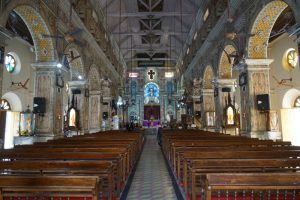 At 3pm, I went to Ayuruville located in a free standing old house for an Abhyanga massage (1300 rupees). The massage room is located on the first floor with elegant decoration. The lady is in her 50s and experienced. I had a an excellent massage which is totally different from the one in Alappuzha.
At 3pm, I went to Ayuruville located in a free standing old house for an Abhyanga massage (1300 rupees). The massage room is located on the first floor with elegant decoration. The lady is in her 50s and experienced. I had a an excellent massage which is totally different from the one in Alappuzha.
Jennifer suggested me see a cultural show at the nearby Kerala Kathakali Center that evening. I was glad I had taken her advice. Before going to the show, I visited the Santa Cruz Basilica the original one had been destroyed by the Dutch. Then I tried to watch sunset by the water with the backdrop of the Chinese fishing nets. Unfortunately as the performance would begin at 6pm, I had to leave before the crimson fireball sank below the horizon.
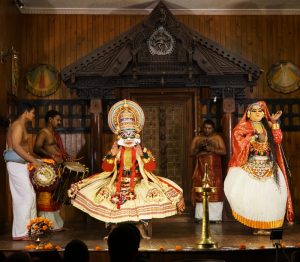
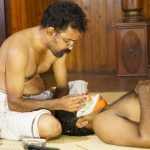 The cultural performance is a must-see. ‘Katha’ meaning ‘story’ and ‘Kali’ meaning ‘play’, is a performance containing mime, drama, music and acting. Kathakali originated in the early 17th century is developed mainly from one of the oldest classic dance forms of Kerala know as ‘Ramanattam’ conducted only in royal places. This art form declined following the decline of royal families. In 1930 a great poet of Kerala Mahakavi Vallathol Narayana Menon tried to revive Kathakali and established an institution. Students have to study for 8-10 years.
The cultural performance is a must-see. ‘Katha’ meaning ‘story’ and ‘Kali’ meaning ‘play’, is a performance containing mime, drama, music and acting. Kathakali originated in the early 17th century is developed mainly from one of the oldest classic dance forms of Kerala know as ‘Ramanattam’ conducted only in royal places. This art form declined following the decline of royal families. In 1930 a great poet of Kerala Mahakavi Vallathol Narayana Menon tried to revive Kathakali and established an institution. Students have to study for 8-10 years.
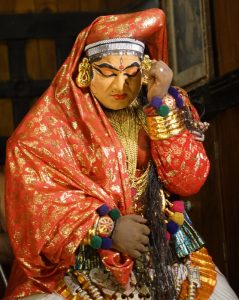 Tonight’s performance was called ‘Kichakavadham’ (the Killing of Kichaka), a story of the Mahabharata. A singer introduced the story with two other musicians playing traditional instruments. Three actors took on the role of Kichaka who is an evil character trying to seduce Malini wife of Bhima who was the most powerful of the five Pandava Princes.
Tonight’s performance was called ‘Kichakavadham’ (the Killing of Kichaka), a story of the Mahabharata. A singer introduced the story with two other musicians playing traditional instruments. Three actors took on the role of Kichaka who is an evil character trying to seduce Malini wife of Bhima who was the most powerful of the five Pandava Princes.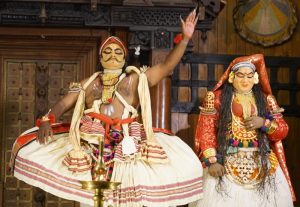
Before the performance at 6pm, audience could watch the three actors painting their faces. Then the actor playing the role of Malini showed us how expressions are made through eye, face and hand movements. I paid 350 rupees for a ticket and found the performance fascinating and eductional. I hope more tourists will see the performance and support the centre.
I chose to sit at the back and stood up to take photos without disturbing others. The man sitting across the ailse did the same. After the performance, a young man sitting on the other side of the aisle commented that I could have taken more photos with my camera. Christian, a German, has been working in Hong Kong since March and now lives in Kennedy Town. What a small world! We had dinner together sharing three dishes at a restaurant called Tea Pot. It cost each of us 500 rupees. Good value!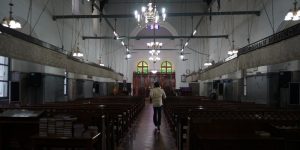
December 10 Sunday
As my train would leave for Goa at 9:30 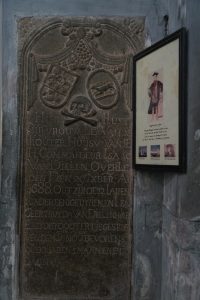 pm, I had a leisure day. I first went to St Francis Church. Christianity spread in the region following the arrival of St Thomas in 52 AD. The first church in India was built of wood in 1503 and dedicated to Saint Bartholomew. The Franciscans made it a permanent structure with bricks and mortar in 1516 and dedicated to St. Anthony.
pm, I had a leisure day. I first went to St Francis Church. Christianity spread in the region following the arrival of St Thomas in 52 AD. The first church in India was built of wood in 1503 and dedicated to Saint Bartholomew. The Franciscans made it a permanent structure with bricks and mortar in 1516 and dedicated to St. Anthony.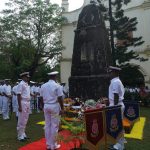
The Dutch converted it to a Protestant Church. Later the British called in “St. Francis Church”. The church renovated in 1776 has a rustic feel with stone floor and many inscriptions and gravestones.
When I arrived, the service had already begun. Though I am not a Christian, I sat respectfully and followed the sermon. From where I sat, I saw the stone over the grave of Vasco da Gama, a last reminder of the explorer who played a defining role in changing the course of history. Without him, my grandmother’s family would not have come and settled in Macau.
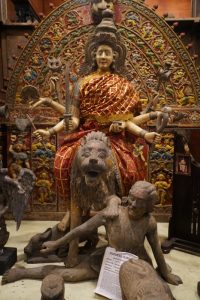 Then I noticed a ceremony in honour of the servicemen was taking place outside. I watched the solemn ceremony for ten minutes before heading to the bus terminal.
Then I noticed a ceremony in honour of the servicemen was taking place outside. I watched the solemn ceremony for ten minutes before heading to the bus terminal.
My second stop was the Kerala Folklore Museum. I took the 8:45am airport bus (20 rupees) and got off close to the museum. It is a private museum with a large collection of old stone sculptures dating as far as 8-9th century, wooden sculptures, jewellry, music instruments, costumes etc. The exhibits spread over three floors.
The ground floor is too crowded and stuffy to my liking. I spent more time on the first and second floors. Though most of the exhibits cannot be compared with those I saw in Mumbai, it is still a private museum worth visiting if one has time.
There is no direct bus back to Fort Kochi. Three teenagers who speak good English offered to call an Uber cab for me. This is an indication of the higher standard of living in this area. The driver said it would cost 95 rupees. But at the end, the driver demanded me to pay 129 rupees. I was annoyed not because of the money but his dishonesty.
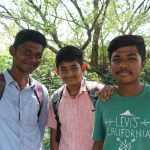 The boys also recommended me have biryani at their favourite restaurant in Mattanchery. But the driver refused to drop me there though it is closer. I therefore got a tuk-tuk and paid 30 rupees for a short ride. It turned up to be the same restaurant I had lunch the day before: I had found my way to the best local restaurant without tips from locals.
The boys also recommended me have biryani at their favourite restaurant in Mattanchery. But the driver refused to drop me there though it is closer. I therefore got a tuk-tuk and paid 30 rupees for a short ride. It turned up to be the same restaurant I had lunch the day before: I had found my way to the best local restaurant without tips from locals.
My third stop was the Mattancherry Palace built by the Portuguese in 1545 AD for the King of Kochi as compensation for plundering a temple in the vicinity. In the complex are two temples, one for Krishna and the other for Shiva. Nearby is a shrine to the goddess Bhagavathy, the family deity. The palace was renovated by the Dutch and thus more popularly known as the ‘Dutch Palace’.
The palace is known for the murals that covers almost every walll, from floor to ceiling. The colourful paintings depict scenes from the Ramayana and puranic stories related to Shiva, Vishnu, Krishna and Devi. There are illustrations on the history of the royal family of Kochi including their portraits.
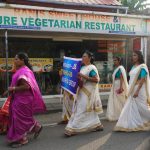 Then I walked to the Jew town close by. Jews, it is said, first arrived in India from Judea, during the reign of King Solomon. They came to be known as ‘Malabari Jews’. Sephardic Jews who arrived when expelled from Spain, were called ‘Paradesi Jews’ and had a strong presence in Fort Kochi. Today, all Jews have left except three Jewish families.
Then I walked to the Jew town close by. Jews, it is said, first arrived in India from Judea, during the reign of King Solomon. They came to be known as ‘Malabari Jews’. Sephardic Jews who arrived when expelled from Spain, were called ‘Paradesi Jews’ and had a strong presence in Fort Kochi. Today, all Jews have left except three Jewish families.
The synagogue built by Paradesi Jews in 1568, is believed to be the most ancient Jewish place of worship in India. It is simple but serene and peaceful. No photo is allowed. The tall clock tower built in 1760 can be seen from the Palace.
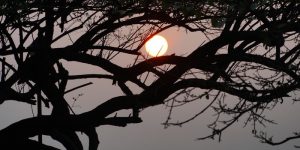
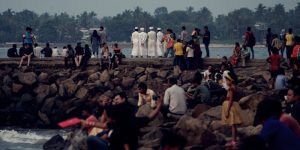 After the stroll, I thought of taking a ferry to go around the harbour. I finally gave up the idea and took a tuk-tuk to return to Pod Cochin Homestay. It’s hot. After a short rest, I ventured out to watch sunset. Unfortunately it was cloudy and there was no sunset. I had a grilled prawns for dinner. Then I said good-bye to Joseph and Jennifer who arranged a tuk-tuk to take me to the railway station.
After the stroll, I thought of taking a ferry to go around the harbour. I finally gave up the idea and took a tuk-tuk to return to Pod Cochin Homestay. It’s hot. After a short rest, I ventured out to watch sunset. Unfortunately it was cloudy and there was no sunset. I had a grilled prawns for dinner. Then I said good-bye to Joseph and Jennifer who arranged a tuk-tuk to take me to the railway station.
I got on board the train around 9pm. To my surprise, there were two beds in a compartment and a male passenger was already in the cabin. He immediately asked the train staff to arrange him to move to another cabin. As a result, I had a cabin to myself! The cabin is acceptable though the blanket does not look clean. I used my sleepbag sheet instead and had a decent sleep!
December 11 Monday
I got up in time to watch sunrise. The countryside looks pleasant and green: rivers, trees and crops in the fields and scattered villages. The attendant served me a continental breakfast with fruit, yogurt, bread etc. I of course had to tip him and he asked for 200 rupees (he said he had an assistant as well!)
At 8:45am sharp, I was told to get off: I was still some 40km from Goa. There is no bus and a taxi ride would be very expensive. I then asked the train station master whether I could take a train to Goa. He told me to take a 40-minute ride on a local train to Karmali for 30 rupees. The train left around 9:30am and I arrived at Karmali an hour later. Goa is still some distance away and I paid a taxi at a fixed-rate of 400 rupees and finally arrived at the Serene Water Hotel in Chimbel.
I found this small family-run hotel by a lake in a small village near Old Goa. Leo, the owner and his wife Jacqueline are in their 40s and converted the ground floor of their house into a guest house with five rooms. The garden is beautiful with mature trees, an infinite pool, geeses, pets and many parrots. It’s hot and went to the pool (which is small) for aqua exercise.
Goa, a state in western India between Maharashata and Kerala with coastlines stretching along the Arabian Sea, has a long history as a Portuguese colony. In 1961, the newly independent India annexed the former Portuguese territories in Goa. Its well-preserved 17th – century churhes in Old Goa (now a World Heritage Site) and beautiful beaches draw pilgrims and tourists all over the world. 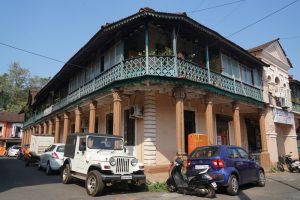
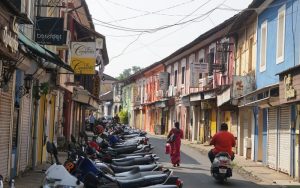 Panaji (also known as Panjim), lying on the banks of the Mandovi River estuary, was the seat of the Portuguese Viceroy since 1759 and was renamed Nova Goa (New Goa) in 1843 to replace the city of Goa (Old Goa) as the capital of Portuguese India. It is now the capital as well as the largest city of the state of Goa. The city with terraced hills, many colonial buildings with balconies and red-tiled roofs and a riverside promenade, retains a Portuguese atmosphere. The avenues are lined with gulmohar, acacia and other trees.
Panaji (also known as Panjim), lying on the banks of the Mandovi River estuary, was the seat of the Portuguese Viceroy since 1759 and was renamed Nova Goa (New Goa) in 1843 to replace the city of Goa (Old Goa) as the capital of Portuguese India. It is now the capital as well as the largest city of the state of Goa. The city with terraced hills, many colonial buildings with balconies and red-tiled roofs and a riverside promenade, retains a Portuguese atmosphere. The avenues are lined with gulmohar, acacia and other trees.
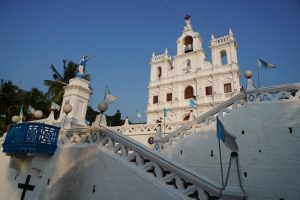 I got off at the bus terminal and walked through the main business area. I ventured out in the afternoon and planned to take a bus. On the way, I stopped in a local eatery and had fish. Disappointing as I did not like fried and oily fish. I got on a local bus and ended up in I finally reached the imposing Baroque Our Lady of the Immaculate Conception Church overlooking the main square Praça da Igreja against colourful villas, cobbled streets and buildings of Portuguese architectures. It is the first city in India to be built on a planned grid system.
I got off at the bus terminal and walked through the main business area. I ventured out in the afternoon and planned to take a bus. On the way, I stopped in a local eatery and had fish. Disappointing as I did not like fried and oily fish. I got on a local bus and ended up in I finally reached the imposing Baroque Our Lady of the Immaculate Conception Church overlooking the main square Praça da Igreja against colourful villas, cobbled streets and buildings of Portuguese architectures. It is the first city in India to be built on a planned grid system.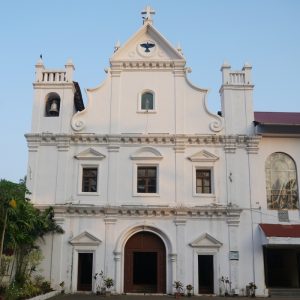
I continued to walk along the main street passing by a Hindu temple before arriving at the Don Bosco Church with a graveyard.
I saw a few nice restaurants, hotels and the military hospital. I reached the Kala Academy with performance venues, exhibition space etc. I arrived at a lighthouse by the Mandovi River. But there was no sunset. I took a tuk-tuk (150 rupees).I had a grilled fish and beer for dinner.
December 12 Tuesday
Old Goa
Portuguese explorer Vasco da Gama first landed in India at Calicut in 1498. Eventually the Portuguese found a permanent base at the present day Old Goa when Afonso de Albuquerque, the first Portuguese Viceroy, drove out the forces of Ismail Adil Shah, the Sultan of Bijapur, in 1510.
Jesuits, Franciscan missionaries and other religious orders arrived and settled in Old Goa. They used it as a centre for the spread of Catholism in India. At its peak it was said that Goa had over 200,000 inhabitants. It was known as “Rome of the East” especially for its splendid and innumerable collection of cathedrals and churches. From the late 17th century, trade competition from Dutch and British led to the economic decline of Old Goa. Eventually the Viceroy moved the capital to Panaji in 1759. Portuguese colonisation in India ended in 1961 when its territories were annexed by India.
Nonetheless, the Portuguese legacy has left behind a set of churches and convents in Old Goa which have been listed as World Heritage properties since 1986. The three justification of the listing are: first, the influence of the monuments in the dissemination of Western art forms – the Manueline styles, Mannerist and Baroque – throughout Asia where Catholic missions were established; second, the value of the monuments as an exceptional example illustrating the work of evangelisation; and third, the specific value of presence in the Basilica of Bom Jesus of the tomb of St Francisco Xavier which illustrates a major world event: the influence of the Catholic religion in Asia in the modern era.
A Day on Hop On Hop off Bus
Goa has recently introduced a ‘hop-on and hop-off’ bus running between Old Goa and Cabo Raj Bhavan. Leo got me a day pass (300 rupees). As my main interest is Old Goa, Leo arranged the driver to pick me up near his guest house around 11am. He took me on his motor-bike to the bus stop. Perfect!
Valentino, young and enthusiastic, was our guide on the bus. I spent five hours in Old Goa visiting six churches, three monuments and a museum (in the order listed below).
Ruins of St. Augustine Church. The Augustinians arrived in the 16th century and founded a convent and a church building from 1597. The original facade was flanked by two huge towers of five floors. All are in ruin except a part of a colossal bell tower, some Corinthian columns, walls, chapels. I also spotted some ceramic tiles. Impressive ruins!
Viceroy’s Arch between the Mandovi River and St. Cajetan Church. The facade has a niche at the top with a statue in stone of Vasco da Gama with original inscription recording that the arch was rebuilt by Governor Francisco da Gama (1597-1600) in honour of his great grandfather.
Gate of Adil Shah’s Palace. The palace was once a magnificient storeyed building with lofty staircases and the most conspicuous building in the city on the eve of Portuhuese conquest. It was the residence of thr governors till 1695. The building became dilapidated and was demolished in 1820. Only the gate remains.
St. Cajetan Church. Italian friars of the Order of Theatines obtained the site in 1665. Modelled on the original design of St Peter’s Church in Rome, this majestic church is architecturally Corinthian with gilded altars and rich carving in Baroque style.
Sé Cathedral. Goa was elevated to the seat of a bishopric in 1534 by Pope Paul III. It is the largest building built by the Portuguese in Asia measuring 91 metres long. It has a Tuscan exterior, three naves which are vaulted and separated by two rows of pillars. The altar piece of the chancel is magnificent and in gilt.
St Francis of Assissi Church. The Franciscan Order was the first to settle in Goa and completed in 1521 a church which was rebuilt from 1661. The facade is narrow and high with an ornamented entrance. The interior has a single vaulted nave with side chapels and transept, covered by impressive stucco and paintings. The floor of the church has many graves with inscriptions and coats of arm. The main chapel has several paintings on the life of St Francis of Assissi and a large gilded altarpiece dating from c1670 with a picture of Jesus on the cross embracing with one arm Francis Xavier.
Archaeological Museum and Portrait Gallery housed in the abandoned convent of St. Francis of Assissi. The rich collection consists of Brahmanical sculptures, hero-stones and sati-stones of the early and late medieval periods, portraits, coins and currency, revenue and court fee stamps, wooden and bronze sculptures and armoury of the Portuguese period. There are many impressive exhibits and the convent building is well-preserved.
Chapel of St Catherine. Built in 1510 by Afonso de Albuquerque to commemorate his entry into the city on St. Catherine’s Day, the chapel is rustic and plain with only one altar. I was the only visitor!
Basilica do Bom Jesus. The Society of Jesus arrived in 1542 and soon created a religious education centre, the College of St. Paul with a huge library and press. But the complex was destroyed in 1830. The Basilica begun in 1594 and consecrated in 1605, is a single nave temple. The facade is of Mannerist style and decorated by pediment with a cartouche with the arms of the Society of Jesus and flanked by scrolls. The main chapel has a golden altarpiece dating from c.1699 dedicated to infant Jesus with an image of Ignatius of Loyola, the founder of the Order.
A silver urn containing the remains of Francisco Xavier(April 7, 1506- December 3, 1552), is located in a mausoleum in the transept chapel. Co-founder of the Society of Jesus and a companion of St. Ignatius of Loyola, he led an extensive mission into Asia mainly in the Portuguese Empire. He was the first Christian missionary to venture into Japan, Borneo, the Maluku Islands and other areas. He died in Shangchuan Island上川岛, China. Thousands of pilgrims flock here every year. The feast of St. Francis Xavier in Goa begins each year from December 3 and continues up to January 2. Huge iron frames for tents had been set up outside the basilica. Hence I could not take a picture of the magnificent building.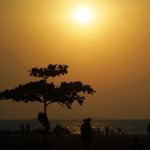
Our Lady of Rosary. Built in 1543, it is the oldest of the Old Goa churches still standing. It looks like a small fortress with the entrance porch flanked by small sylindrical towers with cupolas typical of late-Gothic and Manueline Portugal.
I hopped on the last bus and decided to goto Cabo Raj Bhavan. After getting off at the bus terminal, I still had to walk some 15 minutes. The place was packed with sunset watchers and noisy. I therefore walked back to the bus which could take me back to Panaji at 5:20pm.
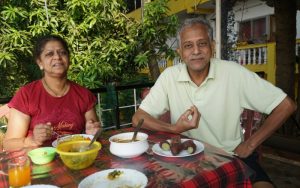 When the bus passed by the Miramar Beach, I saw a most beautiful sunset from the bus. The driver told me to get off at a major intersection to catch a bus which would go near Chimbel. He was half right: the bus took a round-about way. Luckily I have a good sense of direction. Soon I figured out that the bus should go through the side road next to the guesthouse. I was right!
When the bus passed by the Miramar Beach, I saw a most beautiful sunset from the bus. The driver told me to get off at a major intersection to catch a bus which would go near Chimbel. He was half right: the bus took a round-about way. Luckily I have a good sense of direction. Soon I figured out that the bus should go through the side road next to the guesthouse. I was right!
In the evening, I had a lovely dinner in the garden prepared by Jacqueline, Leo’s wife. I met a lovely couple of my age and their daughter from Mumbai. I had three bottles of beer: we talked about everything under the sun!
December 13 Wednesday: Goa – Mumbai, India & End of Tour
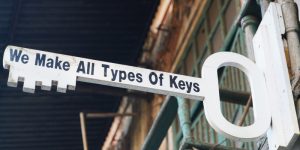 My India trip would end today: I would fly to Mumbai around 5pm and then wait for my 2am-flight to HK at the airport. I like the guesthouse and planned to read in the garden. Jacqueline had to go to Panaji and offered to give me a ride on her motorbike. Fantastic!
My India trip would end today: I would fly to Mumbai around 5pm and then wait for my 2am-flight to HK at the airport. I like the guesthouse and planned to read in the garden. Jacqueline had to go to Panaji and offered to give me a ride on her motorbike. Fantastic!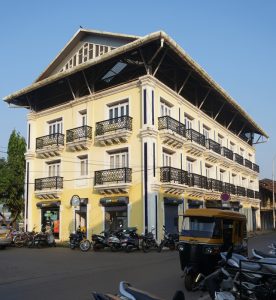
I therefore spent over two hours strolling in the city centre. This time, I strolled along a few back lanes still lined with traditional Portuguese houses. I also went to check out prices of shoes and luggage shops. To my surprise, the brand sports shoes are not much cheaper than those in Hong Kong. A new suitcase from a famous American brand cost almost US$400! Incredible!
Jacqueline prepared me a Goan ‘chicken xacuti’, a most delicious curry dish with coconut. At 2:30pm, I left for the airportis which is about 30km away. I was surprised that the Goa airport has so little to offer and has no paid lounge. The boarding arrangements are also far from satisfactory.
I was in transit through Mumbai. But I could not go through the immigration: the officer told me the information of my 2am-flight was not yet on the screen (i.e. their system). I had to wait in a confined area till 9pm. Incredible!
After going through the immigration check-point, I went to the Premium Lounge with my Priority Pass. But the lounge is small, crowded and noisy with few choices of snacks! I had a cup of instant noodle. I was glad when I could board the plane around 1am. I landed in Hong Kong shortly after 10am on December 14 ending my 35 days in India.


